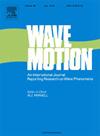Soliton methods and the black hole balance problem
IF 2.5
3区 物理与天体物理
Q2 ACOUSTICS
引用次数: 0
Abstract
This article is an extended version of a presentation given at KOZWaves 2024: The 6th Australasian Conference on Wave Science, held in Dunedin, New Zealand.
Soliton methods were initially introduced to study equations such as the Korteweg–de Vries equation, which describes nonlinear water waves. Interestingly, the same methods can also be used to analyse equilibrium configurations in general relativity. An intriguing open problem is whether a relativistic -body system can be in stationary equilibrium. Due to the nonlinear effect of spin–spin repulsion of rotating objects, and possibly considering charged bodies with additional electromagnetic repulsion, the existence of such unusual configurations remains a possibility. An important example is a (hypothetical) equilibrium configuration with aligned black holes. By studying a linear matrix problem equivalent to the Einstein equations for axisymmetric and stationary (electro-) vacuum spacetimes, we derive the most general form of the boundary data on the symmetry axis in terms of a finite number of parameters. In the simplest case , this leads to a constructive uniqueness proof of the Kerr (–Newman) solution. For and vacuum, we obtain non-existence of stationary two-black-hole configurations. For with electrovacuum, and for larger , it remains an open problem whether the well-defined finite solution families contain any physically reasonable solutions, i.e. spacetimes without anomalies such as naked singularities, magnetic monopoles, and struts.
孤子方法与黑洞平衡问题
本文是在新西兰达尼丁举行的KOZWaves 2024:第六届澳大利亚波浪科学会议上发表的演讲的扩展版本。孤立子方法最初是用来研究描述非线性水波的Korteweg-de Vries方程等方程的。有趣的是,同样的方法也可以用来分析广义相对论中的平衡构型。一个有趣的开放问题是一个相对论的n体系统是否可以处于平稳平衡。由于旋转物体的自旋-自旋斥力的非线性效应,并且可能考虑到带电体的附加电磁斥力,这种不寻常构型的存在仍然是一种可能性。一个重要的例子是(假设的)有n个对齐黑洞的平衡结构。通过研究一个等价于轴对称和静止(电)真空时空的爱因斯坦方程的线性矩阵问题,我们导出了轴对称轴上边界数据在有限个数参数下的最一般形式。在n=1的最简单情况下,这将导致Kerr (-Newman)解的构造唯一性证明。对于n=2和真空,我们得到了稳态双黑洞构型的不存在性。对于n=2的电真空和更大的n,定义良好的有限解族是否包含任何物理上合理的解,即没有裸奇点、磁单极子和杆等异常的时空,仍然是一个开放的问题。
本文章由计算机程序翻译,如有差异,请以英文原文为准。
求助全文
约1分钟内获得全文
求助全文
来源期刊

Wave Motion
物理-力学
CiteScore
4.10
自引率
8.30%
发文量
118
审稿时长
3 months
期刊介绍:
Wave Motion is devoted to the cross fertilization of ideas, and to stimulating interaction between workers in various research areas in which wave propagation phenomena play a dominant role. The description and analysis of wave propagation phenomena provides a unifying thread connecting diverse areas of engineering and the physical sciences such as acoustics, optics, geophysics, seismology, electromagnetic theory, solid and fluid mechanics.
The journal publishes papers on analytical, numerical and experimental methods. Papers that address fundamentally new topics in wave phenomena or develop wave propagation methods for solving direct and inverse problems are of interest to the journal.
 求助内容:
求助内容: 应助结果提醒方式:
应助结果提醒方式:


